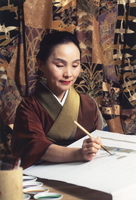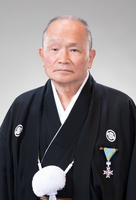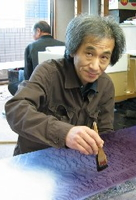In the world of Japanese traditional arts and crafts, only those who have devoted themselves to the transmission and the honing of the arts for a minimum of 12 years can receive the title of “Traditional Master Craftsperson”, and they carry the responsibility to pass on the skills to the next generation. This national certification is granted by the Minister of Economy, Trade, and Industry only to those who excel in the skills and knowledge required to be a true specialist of craftwork. The practical and written examinations for the title of “Traditional Master Craftsperson” are extremely difficult, and the people holding this honorable title are very few.
Traditional Craftspersons at our studio
Takeko Okayama
 |
Takeko Okayama: Japan’s first female Traditional Master Craftsperson of Kyoto’s Yuzen-style. October of the year 2005 saw the second time she received the Kyoto Prefecture’s award for excellent craftspersons of the traditional craftwork in Kyoto. She loves to create kimonos full of dreams, and so she is happiest when she is looking at a blank piece of fabric. She holds solo exhibitions throughout Japan, so you may meet her in your town. Takeko Okayama’s Personal History |
Kozo Okayama
 |
Chairman of Okayama Kougei. Together with Takeko, they are the first couple to be recognized as Traditional Master Craftspersons in Japan. Like Takeko, Kozo has won many awards at numerous competitive exhibitions. In 2014, he was recognized as a Master Craftsperson who has rendered distinguished services in the field of traditional craftwork in Kyoto. He was awarded the Order of the Sacred Treasure, Silver Rays at the Imperial Palace in November 2019. |
Fujio Takahashi
 |
Fujio Takahashi is a musician as well and it seems that his hands holding the brush are moving to a rhythm. He has had a fondness for art from a very young age, having grown up with an artist father. Takahashi specializes in the Ungen Bokashi style of dyeing – a gradation method imported from western China that was commonly used in Buddhist pictures, temple ornaments, etc., during the Nara and Heian Periods. |
